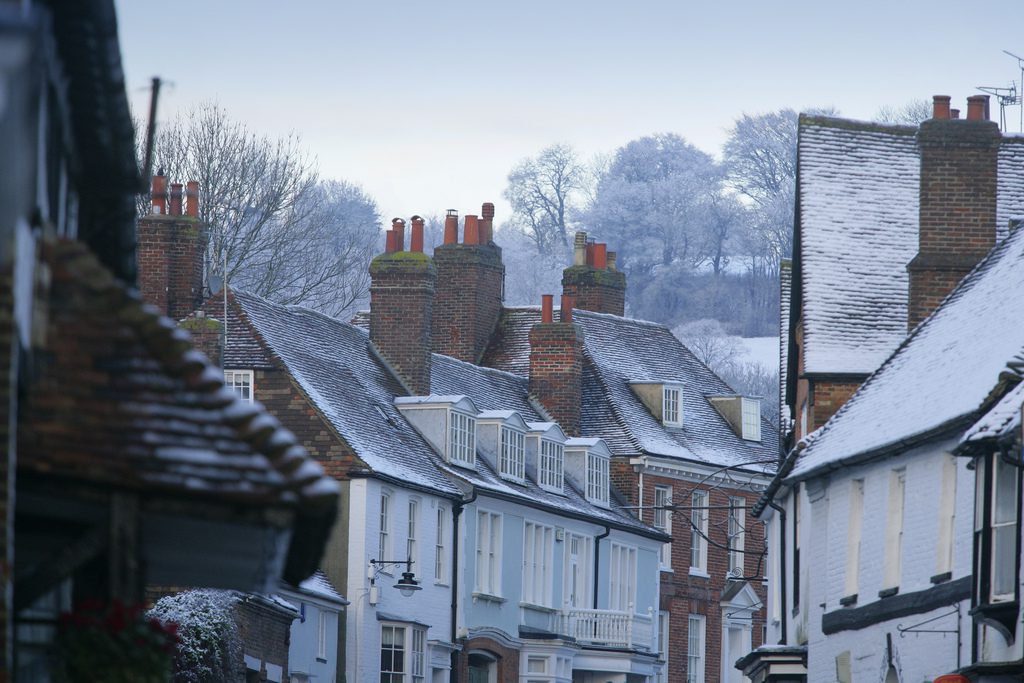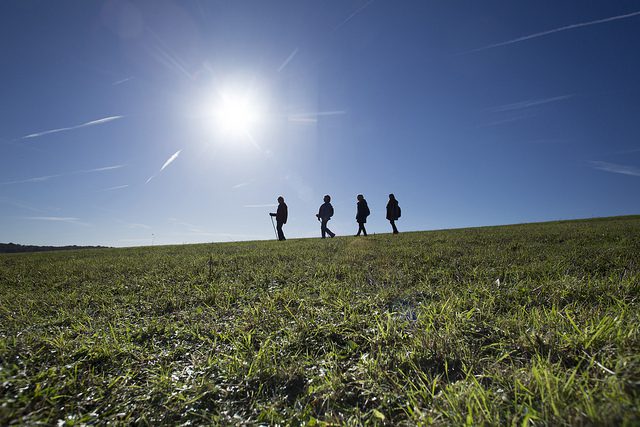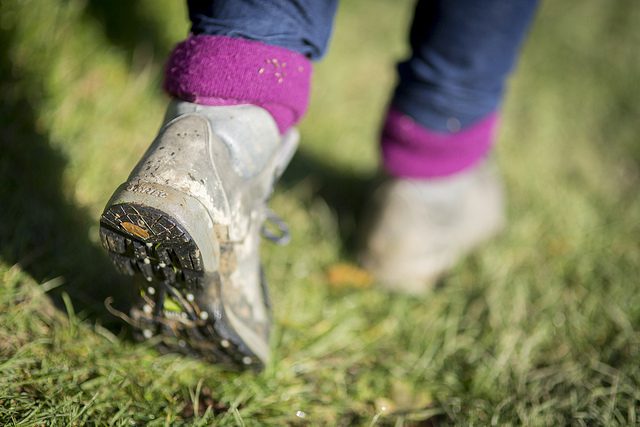North Downs Way’s Top Tips for a Winter Walk

21st December 2016
Walking is a great activity to do all year round and the walking the North Downs Way is no exception! The intrepid North Downs Way trail manager shares with us five tips to make sure you have a great time walking during the Winter and avoid some of the common pitfalls made by walkers:
5 top winter walking tips:
1 Footwear
Be sure to select the right kind of shoe for the occasion and terrain. I’m out and about almost every week of the year I have 3 main pairs of footwear depending on when and where I’m walking.
- In the summer and on well-defined tracks it is possible to do a day’s walking in nothing more than a decent pair of trainers or low cut trail running shoes. They are light and comfortable and I’d wear them year round if I could!
- As the weather gets worse conditions underfoot are likely to deteriorate; you should adjust your footwear choice accordingly. A good mid-weight boot with a good tread and waterproof fabric upper will do for most sections of North Downs Way. This is a good all-round option.
- There are however some steep sections that can get a bit muddy & slippery in prolonged periods of poor weather where a more robust long distance hiking boot with deep treads, ankle support and weatherproofing are recommended.
2 Blisters
There’s nothing worse than that sinking feeling early into your walk when you become aware of a little “hot spot” developing somewhere on your foot where the skin is starting to rub. In order to avoid this, there are some simple steps you can take.
- Choose the correct fitting boot- different brands have different sizing and shoe width. Make sure you try before you buy and take a pair of walking socks with you to ensure you get the right size for you. Conventional wisdom that your walking shoe is half a size bigger than your standard shoe due to thicker socks doesn’t always ring true.
- Choosing good quality socks is as important as the boot itself. Cheap, thin or badly fitting socks can undermine the most expensive and perfectly fitted boot! Some people wear a thin liner sock with a thicker sock over the top. There are some double lined “anti-blister” socks on the market which may suit you. It’s all down to personal preference. My feet seem fairly susceptible to blisters so I often use 2nd skin gel pads with fixing tape on the areas I know I’m prone to blister, which to some may seem a bit belt and braces but I know I’ll finish my day striding rather than hobbling!
- Heel lock for low cut trainers or trail shoes – seems simple but so many people just tie up their boots like a pair of standard shoes. Most boots and trail shoes these days have lace locking systems that generally go unused. The double eyelet at the top of the shoe isn’t there for show! It’s a very handy bit of kit if you know what you’re doing.
3 Clothing
Walking in the UK demands you can adjust to (frequently) changing weather. The easiest way to combat this is to use layers. A good base layer which wicks any sweat away from the skin, a decent mid layer top or fleece and a mid-weight windproof jacket would do the trick in most conditions. If it’s warm you can play around with the layers until you find something comfortable for the conditions. Of course, you need to legislate for some rain. Good lightweight waterproofs which you can pack down into a day pack (with rain cover) are widely available and are a must for anyone walking any significant distance in the UK- particularly in the winter months!
4 Food & Drink
Ensure you’ve got enough liquids and snacks to keep you going. On the North Downs Way we are blessed with plenty of villages, towns and local services along the route. However some of these operate different opening times around the year and others close or change hands so it’s good to have a water bottle (or flask of warm drink) and some snack bars as a minimum to keep you going. If you’re planning a stop off in a pub or café be prepared to remove muddy boots or take a couple of plastic bags to put over your boots to keep the proprietors happy and ensure walkers are welcomed in the future!
5 Plan and Communicate
Make sure you let someone know where you’re intending to walk and roughly what time you plan to start finish. Have a map or guide book, a mobile phone and some waterproof bags to keep them dry, although it’s not always wise to place your faith in your phone as coverage in the countryside is not guaranteed. Once you’ve finished your walk check in with the same person to let them know you’re OK.
Introduction to the North Downs Way
The North Downs Way is one of only 15 designated National Trails in England and Wales and has a diverse appeal for many unique reasons. Passing through 153 miles of stunning and diverse landscapes and through the protected landscapes of the Surrey Hills Area of Outstanding Natural Beauty (AONB) and the Kent Downs AONB the North Downs Way makes for a great place for a family day out, a short walk, ride, a really good ice cream or a life-changing long distance walk.
Easily Accessible
The North Downs Way provides tranquillity from the daily grind, lying just south of London and the urban populations of South East England it is the most accessible of the National Trail lying outside of the Greater London borders. With visitor attractions and country parks dotted along the route there are plenty of reasons to escape stress and noise of modern urban living. Users can walk a short section or use the trail to link between towns and villages or take a country walk around a specific place of interest.
For more information check out the North Downs Way website http://www.nationaltrail.co.uk/north-downs-way
Popular articles
Walking the Pilgrims Way
Experience the beauty of walking across the Kent Downs NL through the…
Inspiring Pub Walks In Kent
With spring just around the corner, now is the ideal time to…
Walk Leader Volunteer Opportunity
Discover how you can become a walk leader in Medway! Uncover the…




